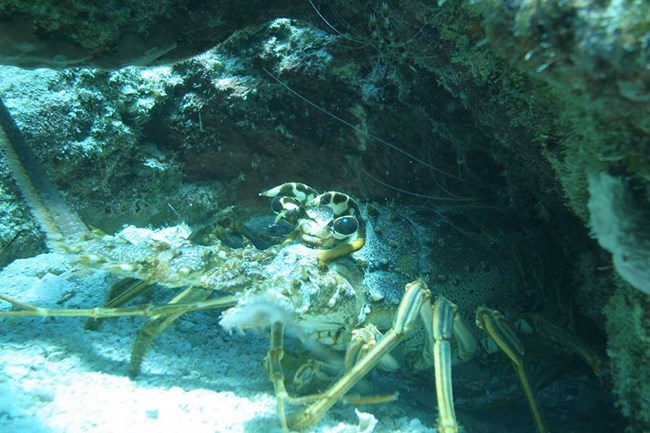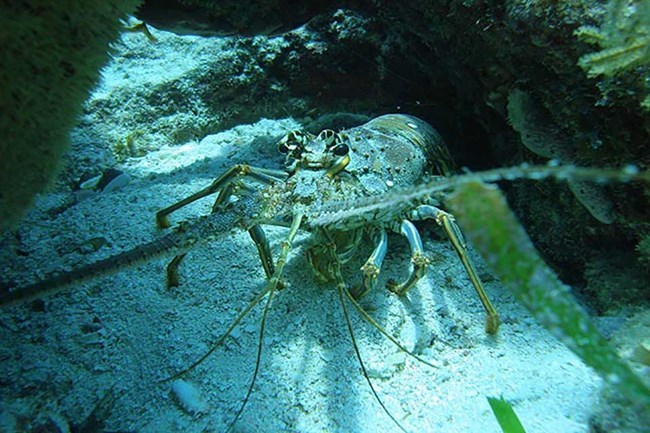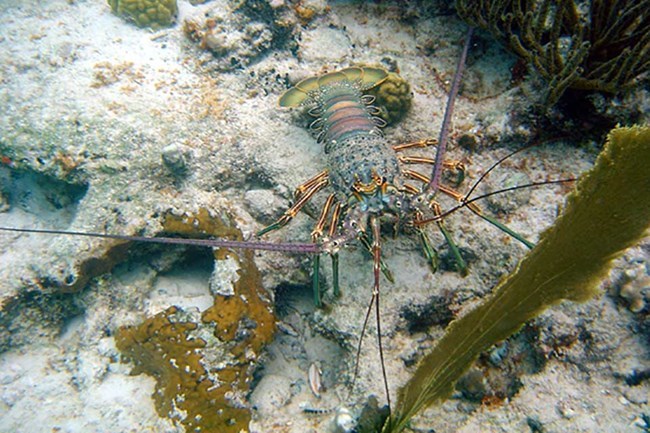Last updated: May 3, 2018
Article
Spiny Lobster Reserves
Spiny lobsters (Panulirus argus) are keystone predators that, by preying on other carnivorous invertebrates in the reef ecosystem, control populations and mediate competition among prey species. The removal of this species thus reduces the biodiversity and resilience of the entire system. Removal of the spiny lobster can also prove a disadvantage for lobster fisheries; a large population of big lobsters at Dry Tortugas National Park, for example, has been shown to be a potential, significant reproductive contribution to local and distant fisheries. Juvenile lobsters can walk out of the park into nearby sport and commercial fisheries, while planktonic larvae can navigate ocean currents for up to twelve months before settling to the bottom hundreds of miles away in the Florida Keys.

NPS Photo
Dry Tortugas National Park
In 1974, after three years of research into the effects of recreational fishing on lobsters in Florida’s Fort Jefferson National Monument (now Dry Tortugas National Park), researchers discovered that recreational divers took nearly half of the available adult lobsters in a single eight-month season. Using the bag limit of two lobsters per person per day, it was estimated that the lobster population would need seven to ten years to recover from each open season. This was not a sustainable practice.
Since the depletion of the lobster population posed both a biological and commercial danger (as explained above), the National Park Service and the State of Florida concluded that protecting the lobsters at Dry Tortugas was the best course of action. To achieve this goal, the NPS created a forty-seven-thousand-acre lobster sanctuary that included habitats for both juvenile and adult lobsters. The benefits of this protection were not immediate, however, as the male lobsters were not yet large enough to breed with the females. It took nearly thirty years for the females at Dry Tortugas to begin producing large quantities of eggs. Once egg laying did start, millions of larvae poured into the ocean currents that swirl around the Florida Keys and flow north into lobster nursery habitats in coastal Florida and Biscayne Bay.

NPS Photo
Biscayne National Park and Everglades National Park
Dry Tortugas was not the only place in Florida where spiny lobsters faced problems. In the 1970s, 95 percent of the lobsters living in southern Biscayne Bay and northern Florida Bay were juveniles; the adult lobsters resided on coral reefs offshore. It was discovered that fishing-related injuries to the juvenile lobsters in these shallow lagoon and bay nurseries reduced their growth rates and substantially increased their mortality rates.
By tagging, releasing, and recapturing nearly fifteen thousand juvenile lobsters over a period of almost a decade in Biscayne Bay and Florida Bay, it was found that as the lobsters approached maturity they walked hundreds of miles out of their bay habitats. Juvenile lobsters from these parks entered fisheries throughout Florida, from Fort Lauderdale to Key West, and up the west coast to Naples. Park officials estimated that if fishing in the nurseries were curtailed, thus preventing fishing-related injuries to the juvenile lobsters, offshore lobster landings would go up at least 10 percent. As an added, and equally important, benefit, lobsters unimpaired by fishing-related injuries would be able to help sustain diverse, productive, and resilient sea grass and bay ecosystems.
The fishing industry and the recreational divers accepted both the injury-depressed growth rates and the movement of tagged lobsters as evidence that nursery reserves would work, and both communities agreed to make the bays off-limits to lobster fishing. The State of Florida established a trial lobster reserve in southern Biscayne Bay in 1979, making it permanent in 1984. The NPS created a lobster reserve in northern Florida Bay in 1980.

NPS Photo
Results
Today, Florida’s spiny lobsters support one of the most successful sustained fisheries in the world, and extensive recreational and commercial fishing activities bolster the local, tourism-based economy. The fisheries’ success is made possible by a network of reserves that protect key areas of the habitat used by lobsters during their adult and juvenile life stages. The key to success was to protect lobsters at multiple life stages, as research clearly showed that both large breeding lobsters, in places such as the Dry Tortugas, and smaller juvenile lobsters, in places like Florida’s coastal bays, were important to successfully maintaining the health of the species. The studies of Florida’s spiny lobsters have helped stewards to better understand the complexity of, and thus better protect, marine ecosystems.
protect, marine ecosystems.
For Further Reading
Natural Resources at Dry Tortugas
Biscayne Bay Card Sound Lobster Sanctuary
Spiny Lobster Fun Fact Sheet
